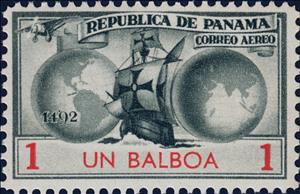Stamp: Columbus (Air Mail) (Cinderellas 1935)
Columbus (Air Mail) (Cinderellas 1935)
01 January (Cinderellas ) within release Panama goes into circulation Stamp Columbus (Air Mail) face value 1 Panamanian balboa
| Stamp Columbus (Air Mail) in catalogues | |
|---|---|
| Colnect codes: | Col: PA 1935-05 |
Stamp is horizontal format.
Also in the issue Panama:
- Stamp - Columbus (Air Mail) face value 1;
- Stamp - Columbus (Air Mail) face value 30;
- Stamp - Columbus (Air Mail) face value 50;
- Stamp - Columbus (Air Mail) face value 10;
- Stamp - Columbus (Air Mail) face value 5;
- Stamp - Columbus face value 2;
- Stamp - Columbus anniversary face value 1;
- Stamp - Columbus anniversary face value 5;
- Stamp - Columbus anniversary face value 10;
- Stamp - Columbus anniversary face value 12;
Stamp Columbus (Air Mail) it reflects the thematic directions:
An aircraft (pl. aircraft) is a vehicle that is able to fly by gaining support from the air. It counters the force of gravity by using either static lift or the dynamic lift of an airfoil, or, in a few cases, direct downward thrust from its engines. Common examples of aircraft include airplanes, rotorcraft (including helicopters), airships (including blimps), gliders, paramotors, and hot air balloons.Part 1 (Definitions and Abbreviations) of Subchapter A of Chapter I of Title 14 of the U. S. Code of Federal Regulations states that aircraft "means a device that is used or intended to be used for flight in the air."
A globe is a spherical model of Earth, of some other celestial body, or of the celestial sphere. Globes serve purposes similar to maps, but, unlike maps, they do not distort the surface that they portray except to scale it down. A model globe of Earth is called a terrestrial globe. A model globe of the celestial sphere is called a celestial globe
A modern sailing ship or sailship is any large wind-powered vessel. Traditionally a sailing ship (or simply ship) is a sailing vessel that carries three or more masts with square sails on each. Large sailing vessels that are not ship-rigged may be more precisely referred to by their sail rig, such as schooner, barque (also spelled "bark"), brig, barkentine, brigantine or sloop. There are many different types of sailing ships, but they all have certain basic things in common. Every sailing ship has a hull, rigging and at least one mast to hold up the sails that use the wind to power the ship. The crew who sail a ship are called sailors or hands. They take turns to take the watch, the active managers of the ship and her performance for a period. Watches are traditionally four hours long. Some sailing ships use traditional ship's bells to tell the time and regulate the watch system, with the bell being rung once for every half hour into the watch and rung eight times at watch end (a four-hour watch). Ocean journeys by sailing ship can take many months, and a common hazard is becoming becalmed because of lack of wind, or being blown off course by severe storms or winds that do not allow progress in the desired direction. A severe storm could lead to shipwreck, and the loss of all hands. Sailing ships are limited in their maximum size compared to ships with heat engines, so economies of scale are also limited. The heaviest sailing ships (limited to those vessels for which sails were the primary means of propulsion) never exceeded 14,000 tons displacement. Sailing ships are therefore also very limited in the supply capacity of their holds, so they have to plan long voyages carefully to include many stops to take on provisions and, in the days before watermakers, fresh water.



